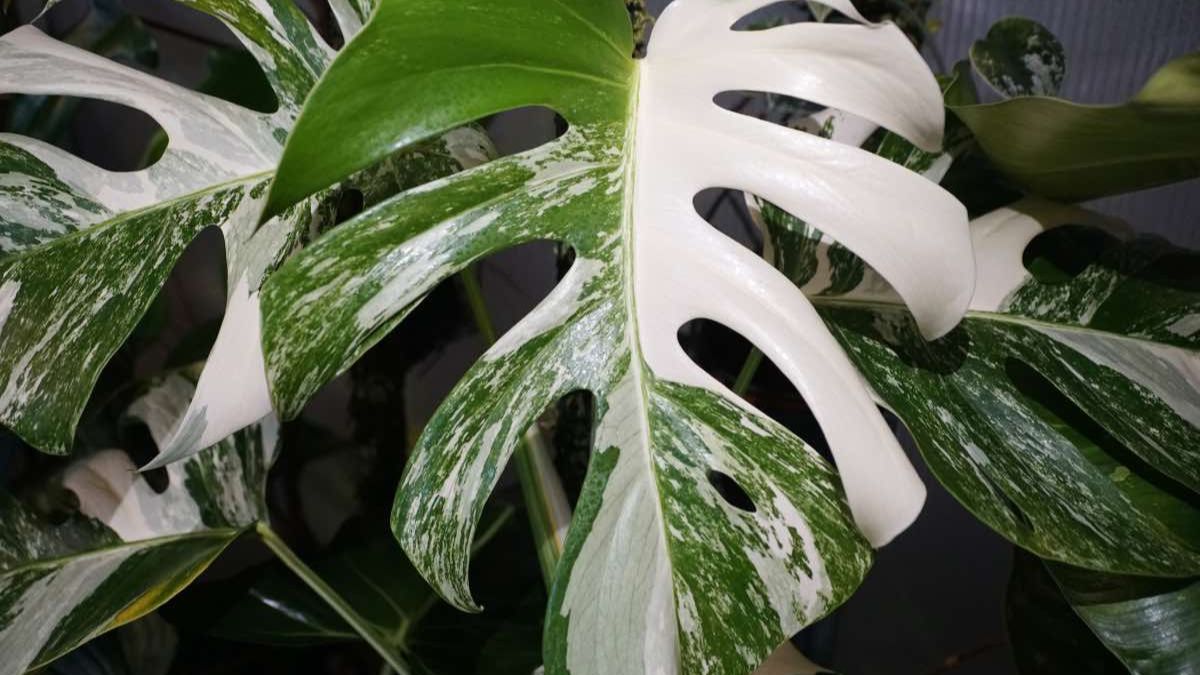TOPIC
Monstera Albo Care Guide | Tips for Growing & Thriving

The Monstera Albo (Monstera deliciosa var. borsigiana albo variegata) is the houseplant that plant enthusiasts everywhere can’t stop talking about—and for good reason! With its striking white-and-green variegated leaves, this plant is a showstopper that brings a touch of the tropics to any home. But as beautiful as it is, the Monstera Albo can also have a reputation for being a bit tricky to care for.
If you’re wondering how to keep your Monstera Albo thriving or are just thinking about getting one, you’re in the right place. This guide will walk you through everything you need to know, from choosing the perfect plant to mastering its care.
What Makes Monstera Albo Special
The Monstera Albo owes its popularity to its stunning variegation. Each leaf features unique patterns of creamy white and deep green, often resembling modern art. This variegation occurs due to a genetic mutation that limits chlorophyll production, giving the plant its signature look. But it’s also what makes Monstera Albo special—no two leaves are alike!
Collectors also love the plant’s fenestrated leaves, those dramatic splits and holes that make the Monstera deliciosa family so iconic. Add in the fact that it’s relatively rare compared to other houseplants, and it becomes easy to understand why Monstera Albo has become a prize possession for many plant lovers.
Where to Find a Monstera Albo
Got your heart set on a Monstera Albo? While they may not be something you’ll find at your local grocery store, they’re worth the hunt.
- Online Nurseries: Businesses like Etsy and dedicated plant shops often have Monstera Albo cuttings or potted plants available.
- Plant Groups: Join Facebook or Reddit groups dedicated to plant lovers. You can often find collectors selling cuttings or swapping plants.
- Plant Markets: Check out plant fairs or specialty nurseries for a chance to snag one in person.
Be ready to pay a premium—the rarity and stunning looks come with a hefty price tag, often ranging anywhere from $150 to $500 or more.
Setting Up the Perfect Home
Once you’ve secured your Monstera Albo, the next step is creating the perfect environment for it to thrive. Its care requirements aren’t vastly different from other Monsteras, but there are some specific nuances to keep your plant happy and healthy.
Lighting: Bright, Indirect Light is Key
Because of its variegated leaves, Monstera Albo needs more light than the average Monstera to compensate for the reduced chlorophyll. Place it in a spot that gets bright, indirect sunlight. A sheer curtain can help diffuse sunlight if you’re worried about scorching the delicate white portions of the leaves.
Pro Tip:
Rotate your plant every couple of weeks to promote even growth and prevent it from leaning toward the light source.
Watering Needs
Monstera Albo prefers a consistent watering schedule. Stick to watering once the top 2-3 inches of soil feel dry to the touch. Be cautious not to overwater—it’s the most common way houseplants meet their demise!
Signs your Monstera Albo needs water:
- Drooping leaves
- Dry, crisp leaf edges
Always use a pot with drainage holes to avoid water pooling at the roots, leading to rot.
Humidity and Temperature
Originating from tropical rainforests, the Monstera Albo thrives in humidity levels between 60-80%. If you live in a dry climate, consider investing in a humidifier or place bowls of water near your plant to naturally increase moisture in the air.
Keep temperatures consistent, ideally between 65°F and 80°F. Cold drafts (like those from windows or air vents) can cause stress to the plant and should be avoided.
Soil and Fertilizer
Use a well-draining soil mix to keep your Monstera Albo happy. A mix of potting soil, peat, and perlite or orchid bark works perfectly, mimicking the airy environment of its natural habitat.
During the growing season (spring and summer), feed your plant a balanced liquid fertilizer once a month. Avoid fertilizing during the winter months when the plant’s growth naturally slows.
Pruning and Propagation
Pruning your Monstera Albo isn’t just about shaping it—it’s also an opportunity to promote healthy growth. Remove any dead or yellowing leaves with sharp, sterilized scissors.
Thinking about sharing your plant with a friend? Or maybe growing your collection? Monstera Albo is relatively easy to propagate.
- Select a healthy stem with at least one node (this is where roots will grow).
- Cut just below the node with sterilized scissors.
- Submerge the cutting in water or moist sphagnum moss and place it in bright, indirect light. Roots should develop within a few weeks!
How to Handle Challenges
Monstera Albo, like any houseplant, isn’t immune to problems. Here’s how to tackle some common issues:
- Yellow Leaves: Could signal overwatering, lack of light, or a nutrient deficiency. Adjust care routines accordingly.
- Brown Leaf Edges: Often caused by low humidity—mist regularly or use a humidifier.
- Pests: Keep an eye out for mealybugs or spider mites. Wipe down affected leaves regularly with insecticidal soap or neem oil.
Why Monstera Albo is Worth the Effort
Yes, Monstera Albo requires a little more care and attention than other houseplants, but the reward is beyond measure. Every new leaf unfurled feels like a gift, and watching your plant thrive is a deeply satisfying experience. Plus, it’s a surefire conversation starter!
Whether you’re a seasoned collector or new to the houseplant world, Monstera Albo is a gem that’s well worth the effort.
Fall in Love with Monstera Albo
The Monstera Albo encapsulates the joy of plant care—watching something extraordinary grow and thrive as a result of your dedication and passion. With this guide, you’ll be well on your way to nurturing your Monstera Albo into a stunning masterpiece.
TOPIC
Enhance Your Sleep: The Benefits of a Mattress Topper Queen

A tranquil night’s sleep is instrumental for our wellbeing and day-to-day functioning. With the extensive array of bedding accessories available in the market designed to elevate sleep quality, selecting the right one is paramount for individual comfort needs. Among these, a mattress topper queen size has gained popularity for its ability to transcend your sleeping experience to new heights of comfort.
What is a Mattress Topper?
A mattress topper is a removable layer that sits on top of a mattress to provide additional support and cushioning. It’s crafted to enhance the feel of your mattress and can be particularly beneficial if your existing mattress is too firm or if you’re seeking an extra layer of comfort without the expense of purchasing a new mattress.
Offering a Customised Comfort Level
One primary advantage of a mattress topper queen size is that it allows you to tailor the firmness of your bed to your liking. Whether you prefer a softer surface that cradles your body, or something that provides firm support to your back, a topper can make all the difference. They come in various materials such as memory foam, latex, down, and wool, each lending a unique comfort profile.
The Convenience Factor
Queen size mattress toppers are particularly convenient as they are easy to install and can be as simple as laying it over your existing mattress, securing it with your fitted sheet. The simplicity of use and the ability to remove and clean them also make mattress toppers an attractive option for maintaining a hygienic sleep environment.
Enhanced Support and Reduced Pressure Points
Alleviating pressure points while you sleep is vital for preventing discomfort and pain. A mattress topper queen can contour to your body, distribute your weight evenly and reduce the stress on pressure points such as hips, shoulders, and knees. This not only aids in a more restful sleep but also minimizes the tossing and turning that often disrupts it.
Extending Mattress Lifespan
If you’re hesitant to invest in a new mattress, a topper can be an excellent way to extend the life of your current one. By absorbing much of the wear and tear, a topper can save the mattress beneath from the brunt of daily use, potentially delaying the need for a costly replacement.
Temperature Regulation
Many modern mattress toppers are designed with temperature regulation in mind. Memory foam, gel-infused toppers, for example, can wick away heat and help keep you cool during the night. A well-chosen topper can be a game-changer for those who tend to sleep hot.
Cost-Effective Comfort Upgrade
With the price of high-quality mattresses being considerable, a mattress topper offers a more affordable way to revitalise your sleep experience. It’s a cost-effective solution that provides similar benefits to a new mattress at a fraction of the cost, particularly beneficial for those on a budget.
Portability and Versatility
A mattress topper queen can easily be rolled up and stored or transported, making it a versatile choice for those who need an additional comfort layer on the go. It’s perfect for guest rooms, travel, or as temporary bedding during a move.
Improved Sleep Quality and Health Benefits
Improved sleep quality can lead to various health benefits, such as enhanced mood, better cognitive function, and a healthier immune system. A comfortable mattress topper can contribute to a deeper state of rest and thereby, overall health improvements.
Choosing the Right Mattress Topper
When selecting a mattress topper, consider the material that aligns best with your comfort preferences, any allergies, and the level of support you need. Pay attention to the thickness and density, as these will impact the comfort and support the topper provides. Additionally, look for quality certifications that indicate the product is free from harmful chemicals.
The Importance of Proper Care
To maximise its lifespan, it’s essential to care for your mattress topper correctly. Follow the manufacturer’s instructions for cleaning and maintaining it, and use mattress protectors to shield it from spills and stains.
Conclusion
A mattress topper queen size is a valuable addition to any sleep setup, offering a multitude of benefits such as customised comfort, enhanced support, and longevity for your mattress. For those looking to improve their sleep without the significant investment of a new mattress, a mattress topper is an ideal solution.
Consider the myriad of advantages, from mitigating pressure points to cost-effective comfort upgrades, a mattress topper can be a transformative sleep accessory. As many have discovered, the addition of a mattress topper queen to their bedding ensemble is the key to unlocking unparalleled slumber night after night.
TOPIC
Effective Pest Control Strategies for Nowra, NSW Residents

Pest infestation is a significant concern for many homeowners in Nowra, NSW. Not only does it pose health risks, but it can also lead to property damage and spoil the peaceful ambience of any household. Understanding the right strategies for pest control in Nowra NSW is essential for maintaining a safe and comfortable living environment. This article will delve into the various effective pest management techniques tailored for residents of Nowra, with a focus on both prevention and eradication.
Understanding the Local Pest Landscape
The first step in effective pest management is recognising the common pests that inhabit Nowra. Each pest species requires a distinct approach for control and prevention. The region’s climate and natural conditions contribute to the prevalence of a variety of pests, from insects to rodents. Thorough knowledge of these pests, their life cycles, and their habits is fundamental for tailoring the correct control strategy.
Regular Home Inspection
Routine home inspections are critical in the early detection of pest activities. These inspections should encompass both the interior and exterior of homes, paying close attention to hidden crevices, dark corners, moisture-prone areas, and entry points. Homeowners should practise vigilance, spotting signs such as droppings, structural damage, or nests, which typically indicate a brewing infestation.
Sanitation and Maintenance
Sanitation cannot be overstated when it comes to pest control. Pests often invade homes searching for food, water, and shelter. Ensuring that all food is stored away in sealed containers, surfaces are regularly cleaned to remove crumbs and spills, and garbage is properly disposed of can considerably reduce the attraction of pests. Additionally, regular maintenance tasks like fixing leaks, sealing gaps, and repairing damage are essential to eliminate possible pest entry points.
Natural and Chemical Repellents
Both natural and chemical repellents can be effective in deterring pests. For those seeking eco-friendly options, natural repellents such as essential oils, diatomaceous earth, or plants like lavender can be utilized as deterrents. In contrast, chemical repellents and baits can provide a stronger, more immediate impact. However, their use should be carefully managed to avoid potential health risks to humans and pets.
Utilizing Traps
Trapping is an age-old method of pest control that remains effective today. Various types of traps are available, depending on the target pest—ranging from sticky traps for insects to baited cages for rodents. Strategic placement and regular monitoring of these traps can significantly reduce pest populations.
Professional Pest Management Services
While DIY methods are invaluable, certain pest infestations require professional expertise. Engaging a reputable provider of pest control services can guarantee a comprehensive assessment of the issue and the implementation of effective, long-term solutions. Professionals are equipped with advanced tools and knowledge of industry-grade pesticides that can safely and efficiently resolve pest problems.
Integrated Pest Management (IPM)
Integrated Pest Management (IPM) is a holistic approach that incorporates several strategies for sustainable pest control. The aim of IPM is to reduce pest populations to acceptable levels using environmentally sensitive methods, which might include a combination of biological controls, habitat manipulation, and the prudent use of pesticides when necessary.
Educating the Community
Involving the local community in pest management can enhance the effectiveness of control measures. Educational initiatives that inform residents about pest prevention methods, as well as the importance of a coordinated approach, help foster a collaborative environment where shared challenges can be tackled more competently.
Monitoring and Evaluation
Consistent monitoring and evaluation of pest control strategies are essential to determine their efficacy. It allows residents to adapt and refine their approach. Tracking pest sightings, recording the success rate of different control methods and remaining adaptable to the changing environment ensures that pest control measures remain effective throughout the year.
Landscape and Garden Care
Outdoor areas contribute significantly to pest management. The careful selection of plants, regular weeding, and proper disposal of garden waste reduce habitats for pests. Additionally, ensuring that landscaping does not provide easy access to the home is pivotal in preventing pest infestations from taking hold.
Seasonal Pest Control Measures
Pests often have seasonal patterns, where certain times of the year are more conducive to their activity. Recognising these patterns allows residents to implement targeted preventative measures. For example, before the onset of warmer weather, which can bring about increased insect activity, residents might focus on sealing their homes and clearing potential nesting sites.
Collaboration with Local Authorities
Local authorities in Nowra often have pest control programmes in place that residents can participate in or learn from. Keeping abreast with municipal pest management plans allows homeowners to complement their efforts with the broader strategies employed by the community, harnessing synergies for improved overall results.
Incorporating Technology in Pest Management
The use of technology has become increasingly prevalent in pest management. Automated pest monitoring systems, smart traps, and data analytics can provide sophisticated approaches to controlling pest populations. Residents embracing these technological advancements can benefit from greater precision and efficiency in their pest control endeavours.
Final Thoughts on Pest Control in Nowra, NSW
Effective pest control requires a multifaceted approach, integrating preventative maintenance, proper sanitation, and targeted eradication measures. For residents of Nowra, NSW, understanding the local pest landscape and leveraging the support of professional pest control in Nowra NSW services, when needed, is crucial. By combining these strategies with community education and technological tools, homeowners can sustain a pest-free environment and protect their homes and health.
Pest Control: A Collaborative Effort for Community Well-being
Ultimately, pest management is not just an individual concern but one that affects the well-being of the entire Nowra community. By employing these strategies and working together, the residents can enjoy their homes and lives without the undue stress brought about by unwanted pests. With the right knowledge and resources, effective and sustainable pest control is within reach.
TOPIC
Juice Head Vape Juice Flavors: Which Ones Are the Best?

The Juice Head brand has really taken the vaping industry by storm over the last few years. They did that by hitting every segment of the market at once with a wide assortment of both bottled e-liquids and disposable vapes. That way, people could experience Juice Head’s flavor selection regardless of whether they preferred refillable vapes or disposables. Releasing products in both categories at the same time helped to make Juice Head one of the world’s leading vape brands, and that’s exactly what they remain today.
At the end of the day, the success or failure of any vape brand depends on the quality of its flavors – and that’s where Juice Head shines. The brand’s flavor selection has made Juice Head vape juice the talk of the vaping community, and we’re going to introduce the full range of Juice Head flavors to you in this guide.
Not sure which option to try first? Here’s a complete roundup of every Juice Head flavor that you can buy today.
Fruit Flavors
Fruit flavors form the main part of Juice Head’s flavor lineup. They’re so core to the brand’s identity, in fact, that they represent almost everything Juice Head offers. You won’t find any plain tobacco or menthol e-liquids here – even most of the brand’s dessert flavors have fruity elements.
One of the fun things about Juice Head’s fruit flavors is that they’re all available with or without menthol. If you prefer a fruity e-liquid with added ice, just look for the version of that flavor with “Freeze” in the name. If you don’t see the word “Freeze,” it’s the standard version of the flavor.
- Apple Watermelon: All aboard for a trip to your favorite summer orchard! Two of your favorite seasonal flavors – crisp red apple and juicy watermelon – coexist here in perfect bliss, giving you a delightful dose of refreshment with just a bit of complexity to keep you interested.
- Blueberry Lemon: Every once in a while, an e-liquid company releases a flavor that transcends the brand and becomes one of the most popular flavors in all of vaping. That’s exactly what has happened with Blueberry Lemon, which is easily the most popular Juice Head flavor that you can buy. If you haven’t tried anything from this brand yet, Blueberry Lemon is definitely the one that you should grab first.
- Guava Peach: Guava Peach is a bit of an east-meets-west flavor, which is a theme that you’ll see often across the Juice Head product line. Guava has a taste that’s rich and slightly musky, and it pairs really well with this flavor’s crisp peach note.
- Mango Strawberry: Mango and strawberry are probably the most popular of all fruity notes in vaping, so why not combine the two? The sweetness of Juice Head’s mango base is perfectly offset by the addition of the slightly tart strawberry.
- Orange Mango: A great mango vape is even better when it’s combined with a flavor that provides a little tang, and that’s exactly what you’ll get here. The orange note brightens the overall flavor profile, creating an experience that’s absolutely irresistible.
- Peach Pear: What’s your favorite juicy summer tree fruit – peach or pear? With Juice Head’s Peach Pear flavor, you won’t have to decide because you can enjoy both of them at the same time.
- Pineapple Grapefruit: Here’s a tropical offering from Juice Head with an extra touch of tartness for anyone who appreciates a vape juice with a sour side. Pineapple and grapefruit are both fairly tangy, but there’s no need to feel overwhelmed because Pineapple Grapefruit has plenty of sweetness on offer as well.
- Pineapple Guava: Pineapple Guava is a flavor from Juice Head that has a good amount of complexity thanks to the nice balance of tangy pineapple and sweet, rich guava. If you appreciate a vape flavor with a tropical vibe, you’ll definitely be a fan of this one.
- Pineapple Orange Guava: This flavor riffs on the classic Hawaiian POG beverage by replacing the traditional passionfruit with pineapple for an experience that’s fresh and different but still unmistakably tropical.
- Strawberry Kiwi: Everyone’s favorite bottled juice in vapor form. You know that you always grab the kiwi-strawberry juice when you walk by the refrigerators at the market; here’s an opportunity to enjoy the same experience without the massive quantity of sugar.
- Watermelon Lime: Most of Juice Head’s fruity flavors provide just a little bit of tartness, but this one is skewed a bit more in that direction. It’s an incredibly refreshing experience.
- Watermelon Strawberry: Why force yourself to choose between watermelon and strawberry when you can enjoy them both at the same time?
Dessert Flavors
While a great fruity e-liquid often has a blend of sweet and sour elements, it’s more common for dessert e-liquids to tend toward the sweeter side of the flavor spectrum. Although Juice Head focuses on fruity flavors with the majority of their flavors, they do have several delicious dessert options for people who prefer a more decadent vaping experience.
- Cake Batter: One of the only Juice Head flavors that doesn’t include a fruity note, Cake Batter proves that this company’s brilliant mixologists can succeed at absolutely anything.
- Fruity Cream: During the height of summer, there’s no better way to enjoy the bounty of the season than by enjoying a simple dessert of fresh fruit with a bit of whipped cream spooned on top. Juice Head’s Fruity Cream flavor recreates that experience flawlessly.
- Strawberry Cream: How can something so simple be so unbelievably delicious? Juice Head’s Strawberry Cream flavor combines a smooth, decadent cream base with a top note of juicy strawberries to deliver the ultimate dessert experience.
- Sweet Cream: If you think that Juice Head’s cream note is good enough to enjoy on its own, this is the flavor for you. Smooth, decadent and complex, Sweet Cream is the ideal flavor to choose when you’re ready to sit back and relax at the end of the day.
Beverage Flavors
Although Juice Head has just one beverage flavor available at the time of writing, it’s a great one. It’s also available with or without menthol. If you want ice, just look for the version that has “Freeze” in the name.
Raspberry Lemonade: Have you ever tried a vape that seemed almost tasty enough to drink? If not, Raspberry Lemonade will definitely make a believer of you. Tasting almost like a pink lemonade, this is a super juicy flavor that more than lives up to the Juice Head name.
-

 TECHNOLOGY3 weeks ago
TECHNOLOGY3 weeks agoTop 10 Must-Read Stories from Kristen Archives You Can’t Miss
-

 TECHNOLOGY6 months ago
TECHNOLOGY6 months agoSky Bri Net Worth Revealed: How She Built Her Financial Empire
-

 TOPIC8 months ago
TOPIC8 months agoBasement Renovation Contractors: How They Tackle Structural Issues During Renovations
-

 TOPIC3 months ago
TOPIC3 months ago5 Reasons the //Vital-Mag.Net Blog Dominates Lifestyle
-

 TOPIC1 month ago
TOPIC1 month agoTop 10 Articles from the ://Vital-Mag.net Blog That You Can’t Miss
-

 CRYPTO5 months ago
CRYPTO5 months agoCrypto30x.com Review: Is It the Right Platform for You?
-

 BUSINESS3 weeks ago
BUSINESS3 weeks agoTraceLoans Explained What You Need to Know
-

 BUSINESS1 month ago
BUSINESS1 month agoDecoding the Kennedy Funding Ripoff Report: Facts vs. Fiction
